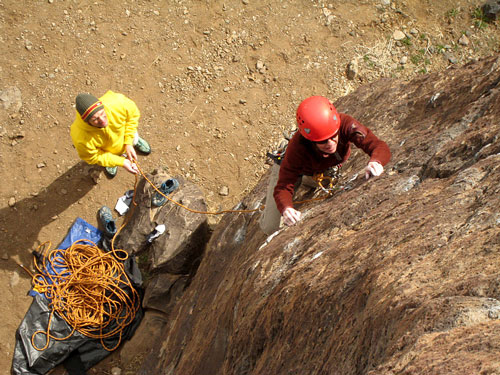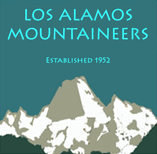|
15.
The Advent of Sport Climbing
LAM History Index |
Go
to Previous Topic |
Go to Next Topic In the mid 1980's the
Mountaineers became aware of a new activity -- sport climbing.
Ironically, many club members first heard of this new sport from Don
Liska, who has been a staunch alpine-style climber all of his life. At
the beginning of one his presentations to the club, Don announced the
new sport and showed the club a magazine article depicting the
achievements of John Bachar, Ron Kauk, and other "Valley Boys" in
Yosemite.
This new form of rock climbing became popular very quickly. A number of
local and visiting climbers began to put up bolt routes in the top
roping areas in White Rock Canyon. Although these new routes were
well-done and very popular, many club members were concerned about the
effect of such permanent changes to climbs that had been considered
classic top rope problems for many years. A few climbers chopped the
bolts on several new routes at areas that had previously never been
bolted, and the club found itself involved in this controversy.
A meeting of Los Alamos and Santa Fe climbers was held in October 1989
to develop a compromise that would provide opportunities for all types
of climbing and prevent further conflicts. The agreement allowed for
bolting at all White Rock climbing areas except the Playground, the "Y,"
the Old New Place, and the New New Place. This agreement can be read in
its entirety by clicking
here. The
agreement has been observed by all climbers for 18 years as of this
writing. The only partial exception to date has been the placement of
some toprope anchors on climbs that were difficult to set safely by
traditional means, especially after the death of the pinon trees during
the 2000-2002 drought. This process has, however, led to some chopping
of the anchor bolts, and as of 2006 this issue has not been resolved.
In concluding his history of top roping in White Rock, Len Margolin said
that, "Long after I ceased to be active in the top roping scene, I heard
about the 'bolt wars,' often heated discussions about whether our top
roping areas should have bolts placed for permanent anchors. I believe
that all of us who began this sport in Los Alamos had high respect and
fondness for the wonderful basalt cliffs, and I believe I speak for all
of us pioneers in thanking those who fought to keep the cliffs free of
bolts. In the early days, it seemed as if there would always be new
areas to find and open up, but now we know that the climbing areas are
finite. I trust the Los Alamos Mountaineers will always serve to protect
this fragile resource for the many generations to come."
After the advent of sport climbing, the Mountaineers began to sponsor an
annual "Meltdown Competition" at the Overlook, held on one weekend in
October. This has often been a very popular event with many participants
of all ages, featuring cookouts and prizes for different categories of
leading and top roping. It has also helped to attract climbers from
other regions to the local cliffs, increasing the popularity of the
area, with both good and bad consequences.
One year, in the mid-1990's, Kim Selvage volunteered to organize the
Meltdown Competition. Being fairly new to the club and not knowing many
of the other members, she just called down the Mountaineers' membership
list to get volunteers. The first call was to George Bell, whom Kim had
not heard of before. George said yes, he would come help. When other
club members heard about this, they were amazed that Kim had
accidentally had the nerve to call such an esteemed senior member to
help out with the Meltdown! As it turned out, both George and Ginny Bell
came to the Meltdown, bringing an ice chest with snacks, and had a good
time.

Fig.
1. Mark Schraad enjoying a sport route at the Gallows Edge
in White Rock (Jason Halladay photo, May 2007).
Nowadays many club
members participate in club or private climbing trips to the fine sport
climbing areas within a day's drive (or less) of Los Alamos. These
include the Overlook and the Gallows Edge in White Rock; the Dungeon in
Los Alamos; Tres Piedras near Taos; the El Rito sport climbing area near
the town of El Rito; Cochiti Mesa and Las Conchas in the Jemez; Diablo
Canyon and the Cockscomb near Santa Fe; Las Palomas Peak in the Sandias;
Penitente Canyon, Eleven Mile Canyon, and Shelf Road in Colorado; Wall
Street in Moab, Utah; Hueco Tanks near El Paso, Texas; and Jack's
Canyon, Datil, and parts of the Cochise Stronghold in Arizona.

Fig.
2. Allison Fritz leads the "Sunny Side Up" warmup climb on the boulder
at the base of the Overlook, with Guido Bender belaying (Jason Halladay
photo, 2007).
Roger Rumsey remembers
that the club's trips to Penitente and to Hueco Tanks provided some
wonderful evenings for socializing. Some of the trips to Penitente
included as many as 15 or 20 climbers, all sharing the small campsite at
the mouth of the canyon and gathering around the campfire or campstove
in the evening. The climbers often shared communal meals and told wild
stories about their climbing adventures.
LAM History Index |
Go
to Previous Topic |
Go to Next Topic
.
|


